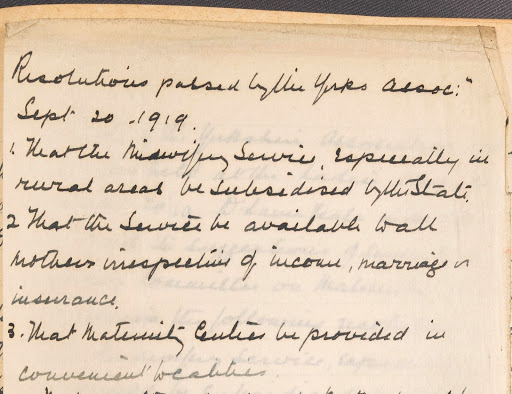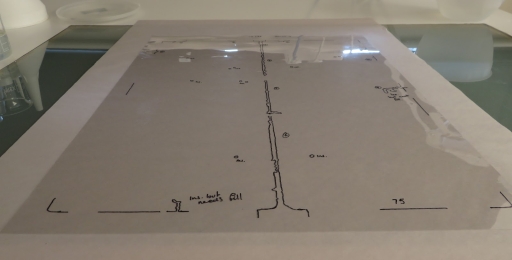Borthwick Newsletter - May 2021
Posted on 30 April 2021
May in the Archives - delve into our catalogues with this month’s featured description
Correspondence and draft scripts for ITV drama ‘Sharpe’s Company’ based on the novel by Bernard Cornwell and adapted by Charles Wood. Starring Sean Bean, it first aired 25 May 1994 [The Charles Wood Archive, CW/2/97/1]
What's New?
It’s been a month of unexpectedly sunny weather in York, perfect for the Borthwick’s first full month back onsite this year. We reopened to university staff and students on the 29th March and to the general public on the 12th April. We are currently open Monday to Wednesday by appointment only and we have a number of measures in place to make your visit as safe and productive as possible. You can read more about them on our website.
Our Searchroom Team have understandably been very busy arranging long overdue research visits, answering enquiries and tackling our backlog of microfilm copying. Searchroom requests have included records from Bootham Park psychiatric hospital, the Mount School for girls, York stained glass firm J.W. Knowles & Sons, and the archive of horticulturalist James Russell, to name just a few.
Elsewhere staff have resumed cataloguing projects, arranged for the transfer of long awaited accessions - and even found time for some nature spotting. Conservator Catherine was lucky enough to see a fox on the grassy bank to the rear of the Borthwick in mid-April and rabbits and geese have been frequent visitors to the still quiet campus.
Speaking of our Conservators, you’ll notice a new section this month - News from Conservation. Cataloguing work and access to our archives is only possible because of the work that our two conservators, Alison Fairburn and Catherine Firth, do behind the scenes. You can read past news from the conservation studio in our March newsletter and April newsletter, but from now on we’ll be including more regular updates!
New Accessions
Now that we’ve returned to site and reopened to researchers we’ve begun to see an uptick in new accessions. In April we accepted eleven gifts and deposits, all additions to existing archives. These included additions to the York Diocesan Archive, our largest and oldest deposit, and to our parish record collection in the form of a new baptism register from the church of St Philip and St James at Clifton, York. We’ve also received a valuable personal addition to the University of York archive, the letters of an undergraduate student who studied History at York between 1965 and 1968, just a few years after the university first opened.
Our environment holdings have also received a boost with the addition of photographic slides of various sites maintained by the Yorkshire Wildlife Trust between 1969 and 1988, including Potteric Carr, Burton Ings, Fen Bog, File Dams and Spurn. The Yorkshire Gardens Trust have also added a digital newsletter (bringing our collections up to 2021) and papers relating to site visits, Trust events and finances between 1997 and 2014. Lastly we were gifted two manuscript music scores created by composer Trevor Hold, the ‘Suite of the Lilford Owl’ for string orchestra, 1977, and ‘A Book of Beasts’, 1984. Hold was influenced by the work of the Northamptonshire poet John Clare and many of his works incorporate themes of the natural world, including ‘Gathered from the Field’ in 1977 which used the words of Clare, and ‘River Songs’ in 1982.
New Catalogues
Not all catalogues are large in size. A new addition to Borthcat in April was a single journal with an important pedigree. It belonged to celebrated York glass painter William Peckitt who used it from the age of 15 to record notes on maths, science and languages - and his burgeoning interest in and knowledge of colour mixing. Peckitt would go on to put this knowledge to good use at sites like Lincoln Cathedral; New College, Oxford; and our own York Minster where he worked on the repair and restoration of the building and painted four windows of his own. Another York glass painter, J.A. Knowles, took a great interest in Peckitt’s life and work, amassing his own collection of research notes and original papers which can be found in our J.W. Knowles and Sons Archive. The Peckitt journal appeared at auction in 2019 and was purchased by a book dealer, but was subsequently bought with the support of the Friends of the University of York Library and Archives; the Noel G Terry Trust and the York Glaziers' Trust for deposit at the Borthwick. We are very glad to have it!
Number of archival descriptions on Borthcat on 1st May 2021: 79,972
The searchroom team have also been making progress with the parish catalogues. Most recently they have added the full catalogues for the parishes of York, St Mary Bishophill Junior; Great Givendale; Osbaldwick with Murton; and Upper Helmsley. If you’re wondering why St Mary Bishophill has a ‘Junior’ designation, it’s because there was in fact a St Mary Bishophill Senior too and the Junior/Senior addition is thought to relate to which church was built first. Just to confuse matters the earliest known mention of either church is that of St Mary Bishophill Junior in a papal confirmation of 1194; but St Mary Bishophill Senior, mentioned in a quitclaim of 1202, was nonetheless believed to be the older church. St Mary Senior was sadly demolished in 1963, but you can still visit the site of the church which is now a community garden. The Borthwick holds the records of both parishes.
News from Conservation
Working at home has had its challenges. In the Conservation Department, we have found the increase in screen time frustrating, we have worried about the unchaperoned building, and like all of the staff here at the Borthwick, we have missed the archives themselves.
But we have also seen many positive outcomes across the year. Both conservators have had the time to set up some practical working practices at home, allowing us to experiment with subjects such as adhesives, binding models and sample mounting techniques. We have also made significant progress on tasks that would have taken much longer if we were also working onsite, such as renewing our Collections Care Benchmarks, updating our disaster control plan, and preparing teaching notes and training sessions, amidst many other activities.

Borthwick staff are now working in 2 bubbles, which means that we are working one week onsite and one week from home. This has been an opportunity for our conservators to develop new working practices once again, as there are some tasks that can be split between home and the workshop. Stock checking our disaster equipment needed to be done in person on site, but we could plan and order the new and replacement materials from home, then incorporate it back into the stock once it was delivered to the building. Data from our environmental monitoring needs to be collected from around the building, but the information can be assessed from home, such as analysing graphs and identifying pests. Additionally, conservation treatments need to take place in the workshop, but handy templates can be created onsite so that paper repair infills can be prepared from home too.
It has been a steep learning curve, but we do feel that there are some valuable benefits from our experience of flexible working, and we are keen to see what the rest of the year holds.
Catherine Firth
Borthwick in the Media
In April The Rowntree Society, the Joseph Rowntree Foundation, the Joseph Rowntree Charitable Trust and the Joseph Rowntree Reform Trust issued an important statement regarding the history of the Rowntree company. The statement addressed the colonial context of the growth of Rowntree & Co and through this the funding of the Rowntree Trusts who were for many years major company shareholders. As part of a research project which began in February 2020 The Rowntree Society, with the support of the Trusts, identified five areas where they believe further research is necessary to ‘create a fuller understanding of how Rowntree businesses benefitted from slavery, unfree labour and other forms of racial exploitation during the eras of colonialism and apartheid.’ These include the practice of colonial indenture, a system of bonded labour in place on plantations owned or used by British confectionery companies until the early 20th century; the purchase of goods from Portuguese-colonised West African islands of São Tomé and Príncipe which used the labour of enslaved Africans; and allegations of racial discrimination at the Wilson-Rowntree factory in 1980s Apartheid South Africa.
As custodians of the archives of the Rowntree company, family and Trusts, the Borthwick Institute welcomed the joint statement, which drew directly from the records in our care. Our statement in response can be read on our website.
Archive of the Month: Yorkshire Association of Medical Women Archive
What is it?
The archive of the YAMW was established in 1917 to safeguard and promote the interests of medical women, and to take action in any matters which concerned them. The Association was also represented in the National Medical Women’s Federation. It succeeded the Leeds and District Association of Medical Women, whose minute book from 1912-1917 is also included in the archive.
Where can I find it?
You can find the full catalogue for the YAMW archive on Borthcat.
Why is it Archive of the Month?
At a time when we are more aware than ever of the importance of the medical profession as a whole, it seems fitting to highlight the work of the pioneering women who established themselves in an overwhelmingly male profession and paved the way for the generations of medical women who came after.
The Yorkshire Association of Medical Women was founded in 1917, a year that also marked the death of the first woman to qualify as a physician and surgeon in the British Isles, the indomitable Elizabeth Garrett Anderson. In 1911, the year before the foundation of the YAMW’s predecessor, the Leeds and District Association of Medical Women, there were only 495 women doctors in the UK. Only a small number of medical schools even admitted women as students, a practice that persisted until 1944 when the government finally made public funding dependent on schools accepting at least a ‘reasonable’ proportion of women.
In such a context the creation and success of organisations like the Leeds and District Association and the Yorkshire Medical Women’s Association gave women a voice in the profession and a forum in which to share ideas, research and, no doubt, support. The archive includes the original rules, details of officers, meeting minutes and a letter explaining the decision to finally disband the Association in 2003.

Its significance lies primarily in the contents of the minute books, which cover topics from national developments such as National Insurance and the NHS, the pay and status of women in the profession, and matters of public health, to matters of particular concern to women, such as maternity and child health, gynaecology, family planning and the introduction of the contraceptive pill. As such the archive is both an important source of information for the history of healthcare in Yorkshire and of women in medicine, and is a very valuable addition to the Borthwick collections.
We’ll see you in June!


